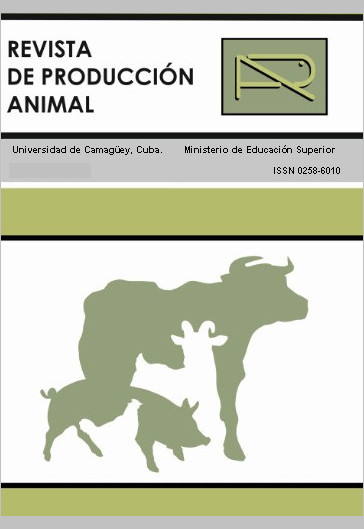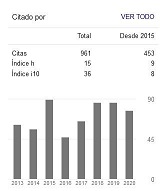Antidiarrheal Effects of Anacardium occidentale L. Leaf Powder on Newborn Chicks
Resumen
To evaluate the antidiarrheal effects of Anacardium occidentale L. leaf powder, 45 two-day old White Leghorn hybrid chicks (L-33) were included in an experiment following a completely randomized design with three treatments, for 8 hours. The feed treatments consisted in basal diet (BD), BD + 1.0 % of Anacardium occidentale L. leaf powder, and BD + 1.5 % of A. occidentale leaf powder. The consumption of feeds accumulated and the initial and final live weights were determined. Besides, the incidence of diarrhea was calculated at 2, 4, 6 and 8 hours after inducing diarrhea with castor oil. Then, five chicks were sacrificed per treatment; the accessory organs of the immune system and the viscera were weighed. The intestinal pH was analyzed and the hematocrit levels were measured. The initial and final live weights, and feed consumption of the newborn diarrheal chickens remained stable (P > 0.05) among the treatments. Likewise, the liver, glandular stomach, muscular stomach, the relative weights of the small and large intestines, and the intestinal pH, did not have statistically significant variations (P > 0.05). Nevertheless, supplementation with the medicinal powder changed (P < 0.05) the relative weight of the pancreas, heart, thymus gland, and bursa of Fabricius. The T2 treatment (1.5 %) decreased the incidence of diarrhea significantly (P < 0.05) compared to the other treatments. However, the experimental treatments did not alter (P > 0.05) the concentration of hematocrits in the newborn chicks. Supplementation of 1.5 % of Anacardium occidentale L. leaf powder is recommended for use in newborn poultry with metabolic diarrhea.
Descargas
Citas
BARRIOS, M. F. (2016). Regulación del metabolismo del hierro: dos sistemas, un mismo objetivo. Revista Cubana de Hematología, Inmunología y Hemoterapia, 32 (1), 4-14.
CAUSEY, H. (2000). Inmunophysiology. Sturkies Avian Phisiology (5th ed.). Oxford, England: Academic Press.
DUNCAN, D. B. (1955). Multiple range and multiple F tests. Biometrics, 11 (1), 1-42.
GIMENO, E. (2004). Compuestos fenólicos. Un análisis de sus beneficios para la salud. Revista de Farmacia, 23 (6), 80-84.
LANDONI, M. F. y ALBARELLOS, G. (2015). The use of antimicrobial agents in broiler chickens. The Veterinary Journal, 205 (1), 21-27.
LICHOVNIKOVA, M.; KALHOTKA, L.; ADAM, V.; KLEJDUS, B. y ANDERLE, V. (2015). The effects of red grape pomace inclusion in grower diet on amino acid digestibility, intestinal microflora, and sera and liver antioxidant activity in broilers. Turkish Journal of Veterinary and Animal Sciences, 39 (4), 406-412.
LIU, G.; AGUILAR, Y. M.; ZHANG, L.; REN, W.; CHEN, S.; GUAN, G.; XIONG, X.; LIAO, P.; Li, T.; HUANG, R.; YANG, H. S.; PARK, I.; Kim, S. W. y YIN, Y. (2016). Dietary supplementation with sanguinarine enhances serum metabolites and antibodies in growing pigs. Journal of Animal Science, 94 (supplement 3), 75-78.
LIU, G.; YU, L.; MARTÍNEZ, Y.; REN, W.; NI, H.; ABDULLAH AL-DHABI, N.; VEERAMUTHU, D. y YIN, Y. (2017). Dietary Saccharomyces cerevisiae Cell Wall Extract Supplementation Alleviates Oxidative Stress and Modulates Serum Amino Acids Profiles in Weaned Piglets. Oxidative Medicine and Cellular Longevity. Retrieved on October 10, 2014, from https://www.ncbi.nlm.nih.gov/pmc/articles/PMC5366236/.
MARTÍNEZ, O.; MARTÍNEZ, Y. y BETANCOURT, C. (2015). Usos milagrosos del Anacardium occidentale (1ra ed.). Montería, Colombia: Gráficas del Caribe.
MARTÍNEZ, Y.; MARTÍNEZ, O.; LIU, G.; REN, W.; RODRÍGUEZ, R.; FONSECA, Y.; OLMO, C.; ISERT, M.; AROCHE, R.; VALDIVIÉ, M. y NYACHOTI, C. M. (2013). Effect of dietary supplementation with Anacardium occidentale on growth performance and immune and visceral organ weights in replacement laying pullets. Journal of Food Agriculture and Environment, 11 (3), 1352-1357.
MARTÍNEZ, Y.; MARTÍNEZ, O.; OLMOS, E.; SIZA, S. y BETANCOURT, C. (2012). Efecto nutracéutico del Anacardium occidentale en dietas de pollitas ponedoras de reemplazo. MVZ Córdoba, 1 7(3), 3125-3132.
MÁS, D.; MARTÍNEZ, Y.; RODRÍGUEZ, R.; PUPO, G.; ROSABAL, O. y OLMO, C. (2017). Análisis preliminar de los metabolitos secundarios de polvos mixtos de hojas de plantas medicinales. Revista Cubana de Plantas Medicinales, 22 (1) (En edición).
MÁS, D.; MARTÍNEZ, Y.; RODRÍGUEZ, R.; SALAZAR, I.; AROCHE, R.; LÓPEZ, B. y MARCELLA, D. (2016). Efecto de la suplementación dietética de polvos de hojas de Psidium guajava y Anacardium occidentale en el comportamiento productivo e incidencia de diarrea de cerdos en pre y post-destete. Revista Computadorizada de Producción Porcina, 23 (10), 106-113.
ROSABAL, O.; MARTÍNEZ, Y.; RODRÍGUEZ, R.; PUPO, G.; OLMO, C. y MÁS, D. (2017). Efecto fitobiótico del polvo de hojas de Anacardium occidentale L. en las dietas de gallinas ponedoras. Revista Cubana de Plantas Medicinales, 22 (1) (En edición).
SAVÓN, L.; SCULL, I.; ORTA, M. y MARTÍNEZ, M. (2007). Integral foliage meal for poultry feeding. Chemical composition, physical properties and phytochemical screening. Cuban Journal of Agriculture Science, 41 (4), 359-361.
SOKENG, S. D.; LONTSI, D.; MOUNDIPA, P. F.; JATSA, H. B.; WATCHO, P. y KAMTCHOUING, P. (2007). Hypoglycemic effect of Anacardium occidentale L. methanol extract and fractions on streptozotocin-induced diabetic rats. Global Journal of Pharmacology, 1 (1), 01-05.
SOUSA DE BRITO, D.; PESSANHA DE ARAU, M. C.; LIN, L. Z. y HARNLY, J (2007). Determination of the flavonoid components of cashew apple (Anacardium occidentale) by LC-DAD-ESI/MS. Food Chemistry, 105 (3), 1112-1118.
UNIÓN DE EMPRESAS COMBINADO AVÍCOLA NACIONAL (UECAN). (2011). Manual Tecnológico para la cría de aves. Ponedoras y sus reemplazos. Ed. por Ministerio de la Agricultura.
YUSUF, S.; ALIYU, M. y NDANUSA, R. (2009). Effect of aqueous extract of Anacardium occidentale (L) stem bark on sodium and chloride transport in the rabbit colon. Journal of Medicinal Plants Research, 3 (6), 493-497.
Los autores de los artículos publicados en RPA retienen los derechos de autor de su trabajo, de marca y patente, y también sobre cualquier proceso o procedimiento descrito en el artículo, así como a compartir, copiar, distribuir, ejecutar y comunicar públicamente el artículo publicado en la RPA o cualquier parte de aquel siempre que indiquen la fuente de publicación (autores del trabajo, revista, volumen, número y fecha), pero están de acuerdo en que la revista publique los trabajos bajo una licencia Creative Commons.
![]() Licencia Attribution-NonCommercial 4.0 International (CC BY-NC 4.0)
Licencia Attribution-NonCommercial 4.0 International (CC BY-NC 4.0)






































